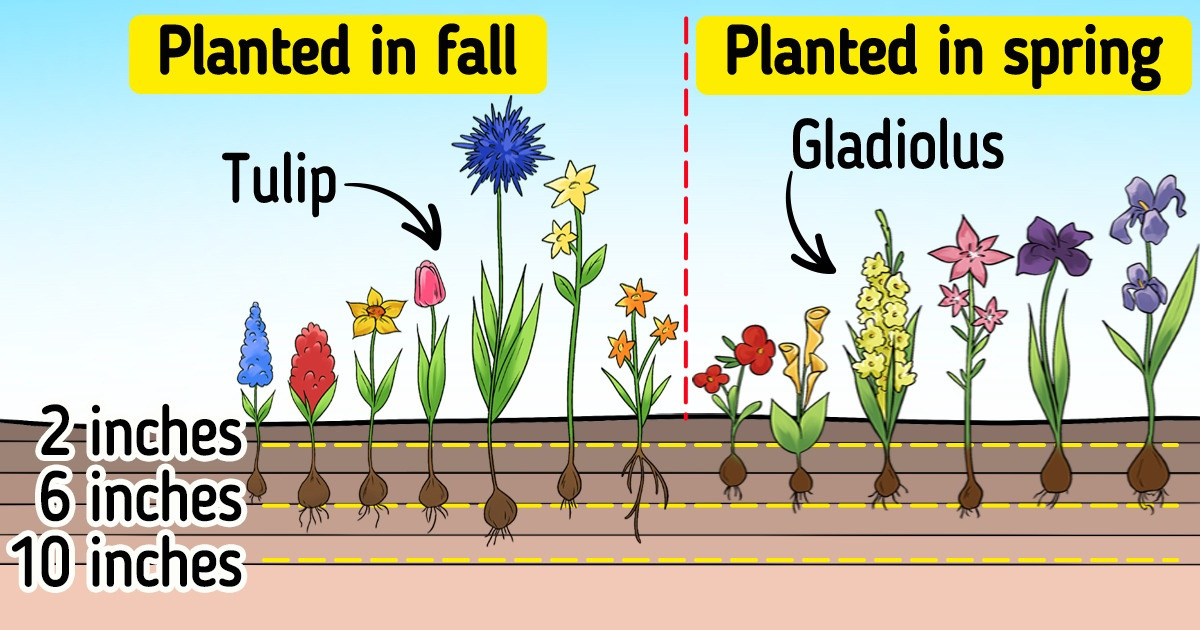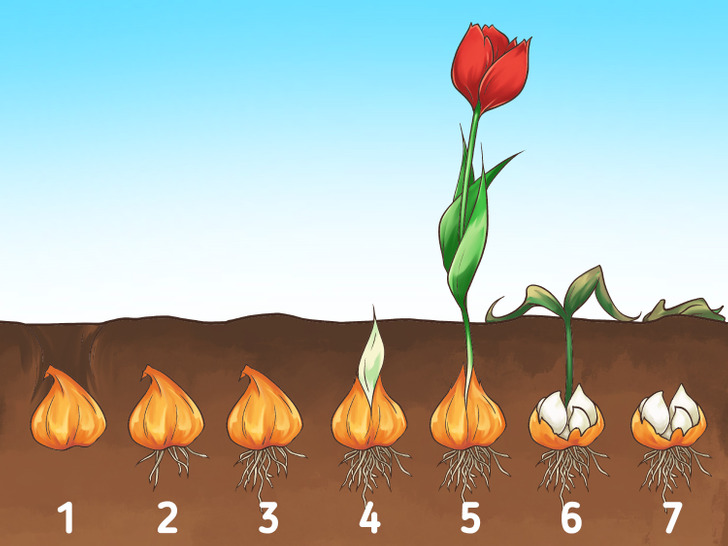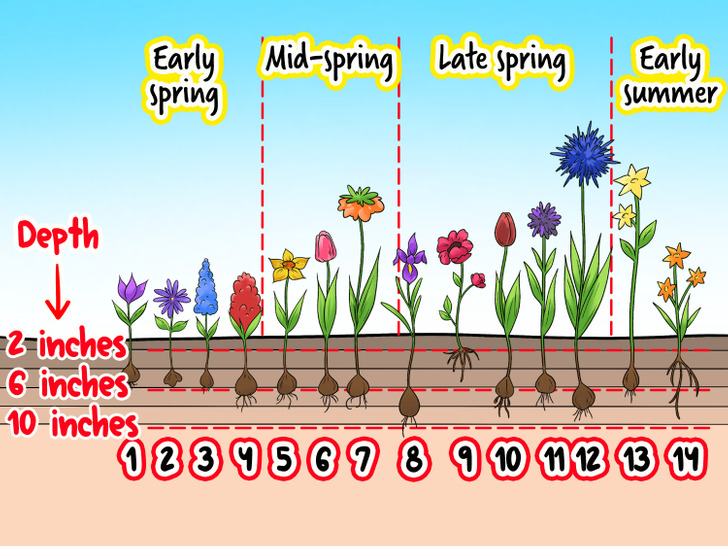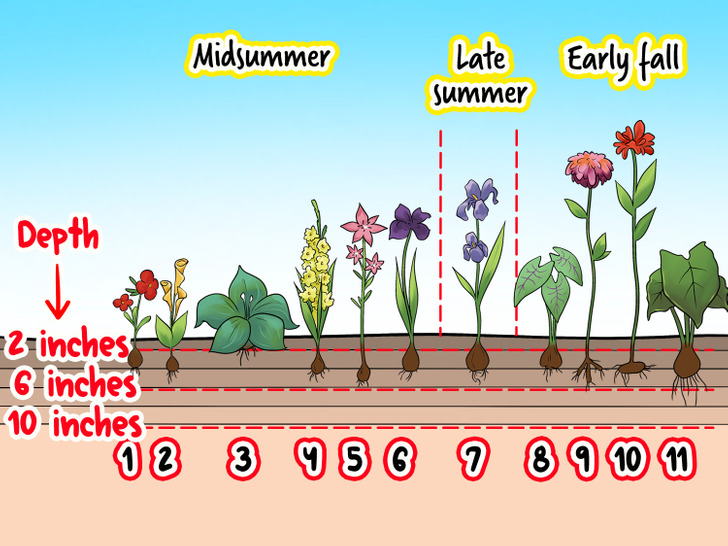How to Grow Plants From Bulbs

Tulips, daffodils, and hyacinths are all bulbous plants that delight us with their flowers in spring when most other plants are still waking up from winter sleep. Bulbs also include summer flowers like irises and peonies, which bloom later. All these plants are so easy to plant and grow, even beginners can manage them.
5-Minute Crafts would like to tell you about how to grow a plant from a bulb.
The life cycle of a bulb

Let’s take a tulip bulb as an example to understand the life cycle of a bulbous plant.
- Planting time: September or October is the best time to plant tulips. At this stage, a bulb doesn’t yet have roots, so it’s usually planted twice as deep as the bulb is high.
- Making roots: In November, roots start growing out of the base of the bulb. They take nourishment out of the soil while the mother bulb gets ready for winter.
- Cooling period: This period lasts from December to January, and it’s important for the bulb to bloom in the future. Frost at this time is harmless to the bulb and the roots.
- Growing period: This falls in the period from February to March. Gradually, the leaves and flower appear from the bulb.
- Blooming period: In April and May, tulips actively bloom, receiving nourishment from the roots. The bulb’s skin becomes dark.
- Regeneration: In May or June, when the blooming of tulips ends, the blooms are cut. The leaves are left to stimulate the growth of new bulbs.
- Multiplying: July to September is the period when up to 5 new bulbs grow on the mother bulb. They slowly form their roots so that tulips can bloom again next year.
Important: Most bulbs are perennial. For example, crocuses and daffodils bloom year after year. But there are also annuals among bulbs or plants that you need to dig out of the ground and replant in a warm place to protect them from the destructive winter frost.
When the best time to plant a bulb is

Plants in the picture: 1 — Crocus, 2 — Anemone Blanda, 3 — Muscari, 4 — Hyacinth, 5 — Daffodil, 6 — Darwin Hybrid Tulip, 7 — Fritillaria Imperialis, 8 — Dutch Iris, 9 — Peony, 10 — Late Tulip, 11 — Allium, 12 — Allium Giganteum, 13 — Asiatic Lily, 14 — Daylily
Some bulbous plants should be planted in the ground in fall to see them bloom in spring. These plants include onion, amaryllis, anemone, crocus, daffodil, Muscari (grape hyacinth), hyacinth, iris, lily, poppy, peony, and tulip. Look at the picture above: the bulbs of these plants sit in the ground at a depth of 4-8 inches, and many of them begin to bloom even before the first leaves appear on the trees.

Plants in the picture: 1 — Begonia, 2 — Calla Lily, 3 — Hosta, 4 — Gladiolus, 5 — Oriental Lily, 6 — Siberian Iris, 7 — Bearded Iris, 8 — Caladium, 9 — Dahlia, 10 — Canna, 11 — Elephant Ear
Other bulbs are planted in spring to bloom in summer. These flowers include anemone, astilbe, begonia, caladium, zantedeschia, canna, hosta, crocosmia, dahlia, daylily, gladiolus, iris, liatris, phlox, peony, and echinacea. Their bulbs sit a little closer to the surface at a depth of 2-4 inches.
How to choose a bulb
Good bulbs should be big enough, fresh and firm to the touch, and have no signs of rot or mold. Choose bulbs whose husk is not damaged: it helps the plant fight various diseases. As soon as you get the bulbs, plant them right away or keep them in a dry, cool, dark place at around 60°F to 65°F. If the storage place is warmer, the bulbs may deteriorate.
What you need to know before planting a bulb
- Can bulbs freeze in winter?
Most fall-planted bulbs survive winter. But many spring-planted bulbs will die, so in fall, it’s recommended to cut off their leaves (which wilt due to the first cold weather), get them out of the ground, and wrap the dry roots in a paper bag. Then you need to keep them in the pantry, where it is dry and the temperature doesn’t drop below 32°F. With the coming of spring, bulbs can be planted again.
- Should you plant bulbs in the shade or in the sun?
These plants love the sun but feel good in partial shade too. Fall-planted bulbs will begin to bloom before foliage appears on the trees, which means there will be almost no shade. At the same time, it’s better not to plant them under evergreens.
- Do you need fertilizer?
You don’t need any when it comes to fall-planted bulbs. But spring-planted bulbs, such as dahlias, can be fed when they begin to bloom.